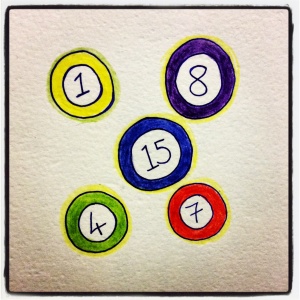This game is simple to set up and can be done at any stage.
Rules:
Each student picks 9 secret numbers between 1 and 15.
They need to write these 3 down and 3 across. This is an example grid:
|
3 |
9 |
11 |
|
14 |
1 |
15 |
|
8 |
7 |
2 |
There are a number of ways to play the game.
a.) You can test students on lexical terms at the end of a unit or from a previous lesson. You need about 15 lexical terms. You might not use them all. These aren’t related to the numbers on the grid.
b.) Students can think of their own questions to test each other. You will need 15 questions. Again, you might not use all of your questions.
You can select which students answer the questions, or the last student who answered correctly gets to select a person of their choice for the next question. If a student gets the question wrong, pick someone else to answer.
If a student gets the answer correct, they select a number from their grid. Get them to shout it out for all to hear. If anyone else in the class has that same number, they cross the number off as well. The key point here is that all students are paying attention and involved!
You can play the game according to time. Play for a line if time is short. Alternatively, play for a full house if you have time and the students are eager to continue!
Players shout LINE when they have 3 in a row; BINGO when they have a full house. A full house means all 9 numbers have been crossed off.

i need to lean through somaone i will ask qeusions for what i need to know and understand .
LikeLike
Ok, Jeremiah. Let me know how it goes. Practice makes perfect!
LikeLike
Hello, couçd you please explain better how it works? thanks
LikeLike
Hello, let me know what part you don’t understand and I’ll see if I can help.
LikeLike
I’ve made some changes to my instructions so I hope it clarifies the activity.
LikeLike
816
357
492
LikeLike
I think the missing link is: How do you change the numbers into questions on vocabulary for example 🙂
LikeLike
Hello Elizabeth Anne, You always keep it as numbers. If the students or you are asking questions, you still need the numbers on the grids. If they get that question correct they can select a number from their grid to cross off.
Does this help? I hope so! Let me know if not.
LikeLike
Also the numbers are unrelated to the questions you use. You can create any sorts of questions you want to test your students. The numbers are a reward for them to cross off if they get a question correct.
LikeLike
sounds great! Could be used with a list of sentences with mistakes from their own homework as an error treatment activity. Or with phrasal verbs as a revision, students provide the particle or the verb in a sentence containing a phrasal. thanks!
LikeLiked by 1 person
Oh yes! That’s a lovely idea! I had never thought to use it as error correction/feedback. I like it! Thanks Noemi!
LikeLike